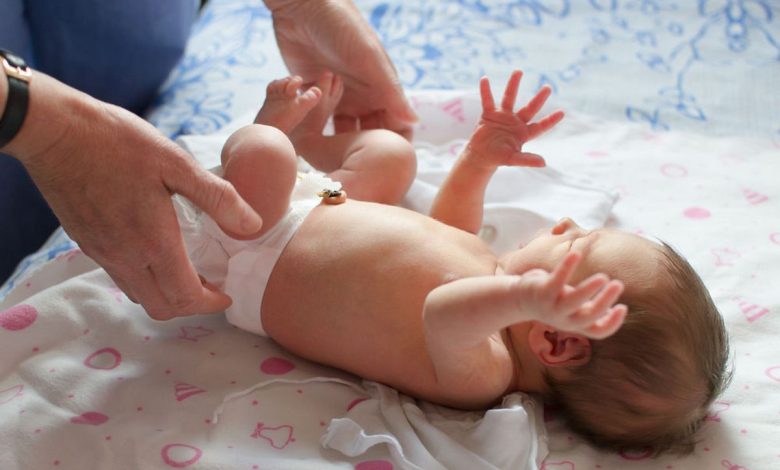Sunken (sunken) fontanel in an infant: What's it, causes, symptoms, diagnostics, treatment, prevention

Fontanelles – sunken; Sunken fountains; Soft spot – sunken
An infant's fontanelles are two separate diamond-shaped openings, located on the front and back of the baby's skull.
Sunken (sunken) fontanel in infants is often caused by a medical condition, called craniosynostosis, which is the premature closure of the sutures in the skull.
The skull is made up of several bones., interconnected by fibrous tissue, called seams. Although these sutures usually remain open until about two years of age., their premature closure can lead to a sunken fontanel. Usually anterior, or frontal, the fontanel is larger and more pronounced, than rear, or occipital, fontanel.
Causes of sunken fontanelles
Sunken fontanelles can occur for various reasons., including:
- Dehydration. Lack of fluid in the body can lead to deepening of the fontanelles. Babies and young children are especially prone to dehydration, which may be due to illness, fever, diarrhea or insufficient fluid intake.
- Meningitis. This is inflammation of the membranes, surrounding the brain and spinal cord. This can lead to sunken fontanelles and is often accompanied by other symptoms., such as fever, headache and stiffness in the neck and back.
- Malnutrition. Improper nutrition can lead to deepening of the fontanelles. This may be due to a lack of essential nutrients in the diet or due to a medical condition., which interferes with the absorption of nutrients.
- Craniosynostosis. This condition, in which the bones of the skull fuse too early, before that, How does the brain fully develop?. This can lead to premature closure of the fontanelles and may require surgery..
- Other diseases. Some diseases, such as hydrocephalus or a brain tumor, can cause fontanelles to recede. These conditions require immediate medical attention.
Symptoms of sunken fontanelles
The main symptom of sunken fontanelles is a noticeably smaller, diamond-shaped opening in the front or back of an infant's skull., usually in both cases. This can be observed on physical examination of the infant's head and can often be felt., touching this area. Symptoms may include deformity, bulging or displaced head and even abnormal facial features.
Other symptoms may vary depending on the underlying cause and may include:
- Reduced diuresis
- Dry mouth and tongue
- Irritability or lethargy
- Poor appetite
- Constipation
- Headache
- Vomiting
- Seizures
When to see a doctor
If your child shows any symptoms of sunken fontanelles, it is important to contact a health worker and ask him to examine the child. Although craniosynostosis is usually diagnosed on physical examination, it is important to rule out any other potential causes of sunken fontanelles.
Questions, that your doctor may ask
Your doctor, probably, ask you a series of questions, to diagnose the cause of a sunken fontanel. These questions may include:
- How old is your child?
- Do you know any factors, which could lead to craniosynostosis during pregnancy?
- Are there any other symptoms besides a sunken fontanel?
- Does your child have any other medical conditions?
Diagnosis of sunken fontanelles
After, how you ask the right questions and complete the physical examination of the baby, your doctor may decide to have additional tests to confirm the diagnosis. These tests may include x-rays of the child's skull., computed tomography and MRI. After receiving the results of the tests and confirming the diagnosis, the doctor will discuss with you the best course of treatment for your child..
Treatment of sunken fontanelles
Surgery is the main treatment for craniosynostosis.. In this procedure, the surgeon will open the prematurely fused suture, to allow the brain and skull to grow normally. This type of surgery can sometimes be done in infancy., and is usually followed by periods of observation, To make sure, that the operation was successful.
Home treatment for sunken fontanelles
In some cases, you can treat yourself at home., to reduce symptoms, associated with craniosynostosis. Some of the most common include:
- Correct position of the baby. Proper positioning of the infant can help relieve pressure on the cranial sutures.; It can be done, laying the baby on his back with his head slightly raised. It is important to note, that, depending on the severity of the condition, a special safety helmet may be required.
- Physiotherapy. Physical therapy may be recommended for children with mild cranial sutures due to stretching and massage exercises, which it includes, which can help relieve pressure from stitches.
- Treatment with eye patches: to prevent eye movement disorders, such as strabismus, treatment with eye patches may be recommended. This includes taping a stronger eye, to help strengthen the weaker.
Prevention of sunken fontanelles
Unfortunately, there is no known way to prevent craniosynostosis. Nonetheless, there are some steps, you can take, to reduce the risk of disease:
- Avoid certain drugs and chemicals. Certain drugs and chemicals, such as thalidomide and alcohol, may increase the risk of developing craniosynostosis in infants, therefore it is important to avoid their use during pregnancy.
- Control of certain diseases. Medical conditions, such as gestational diabetes and Down syndrome, may increase the risk of developing craniosynostosis, therefore, it is important to properly manage these conditions during pregnancy.
- More regular checkups. Regular check-ups with your doctor will help keep track of any changes in the size or shape of your child's skull., which may be a sign of craniosynostosis.
Used sources and literature
Goyal NK. The newborn infant. In: Kliegman RM, St. Geme JW, Bloom NJ, Shah SS, Tasker RC, Wilson KM, eds. Nelson Textbook of Pediatrics. 21st ed. Philadelphia, PA: Elsevier; 2020:chap 113.
Wright CJ, Posencheg MA, Series I, Evans Jr.. Fluid, electrolyte, and acid-base balance. In: Gleason CA, JUUL SE, eds. Avery’s Diseases of the Newborn. 10th ed. Philadelphia, PA: Elsevier; 2018:chap 30.
